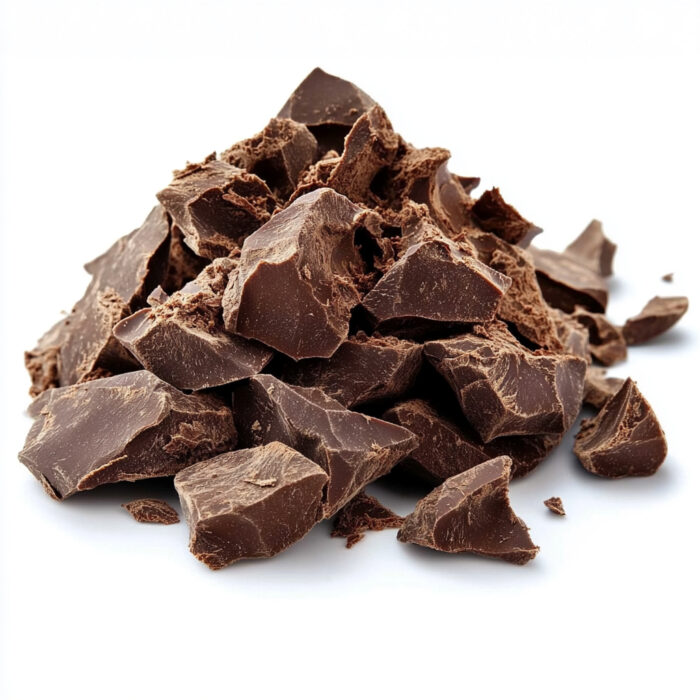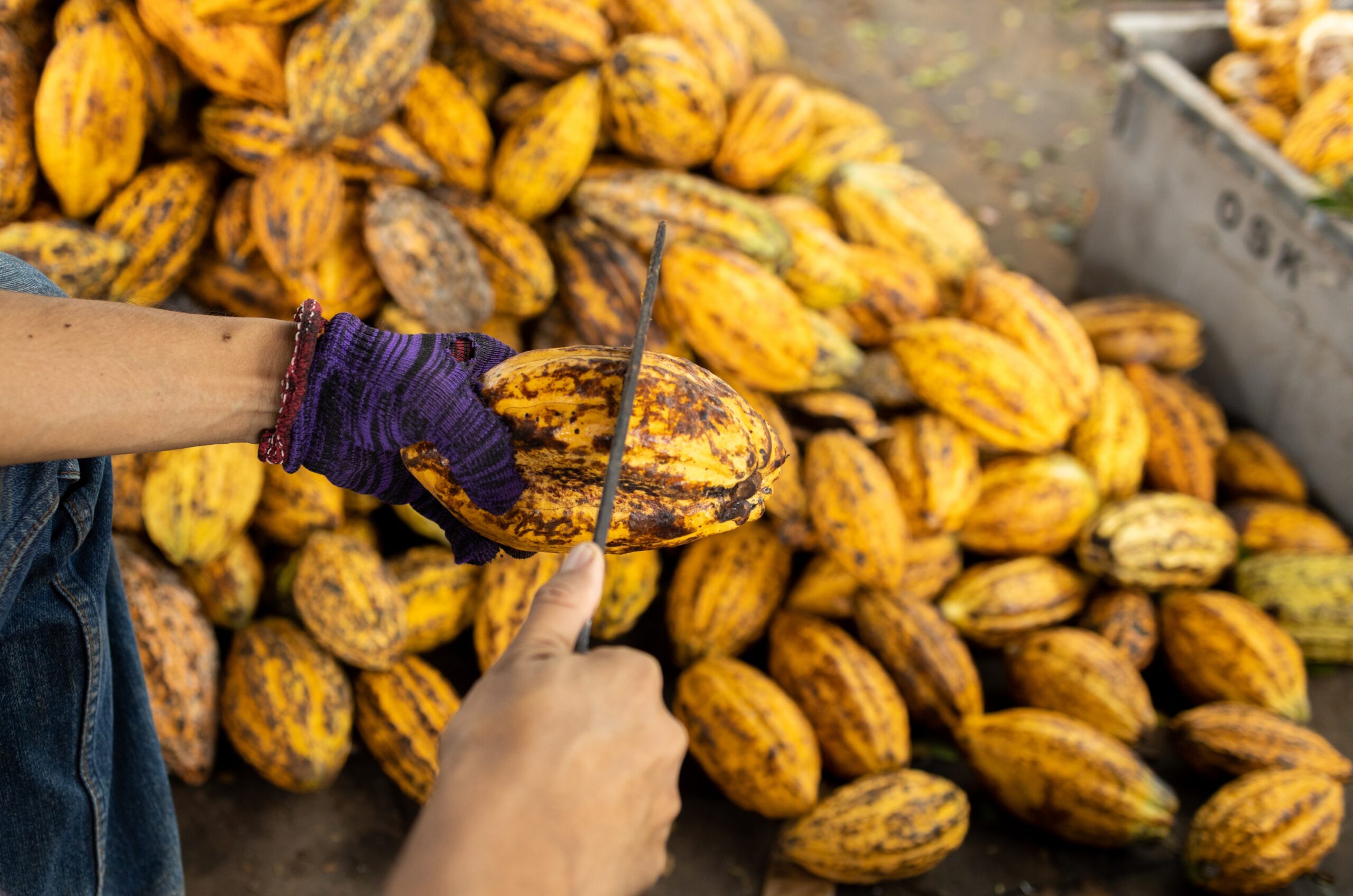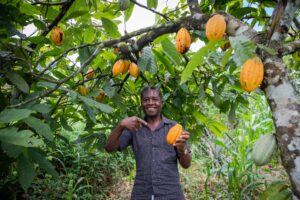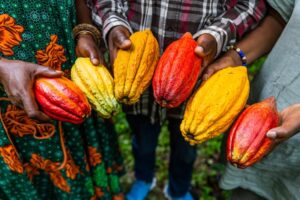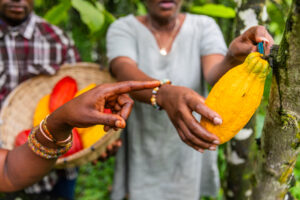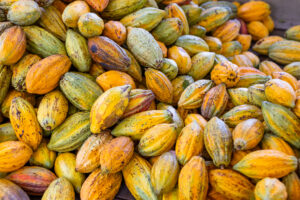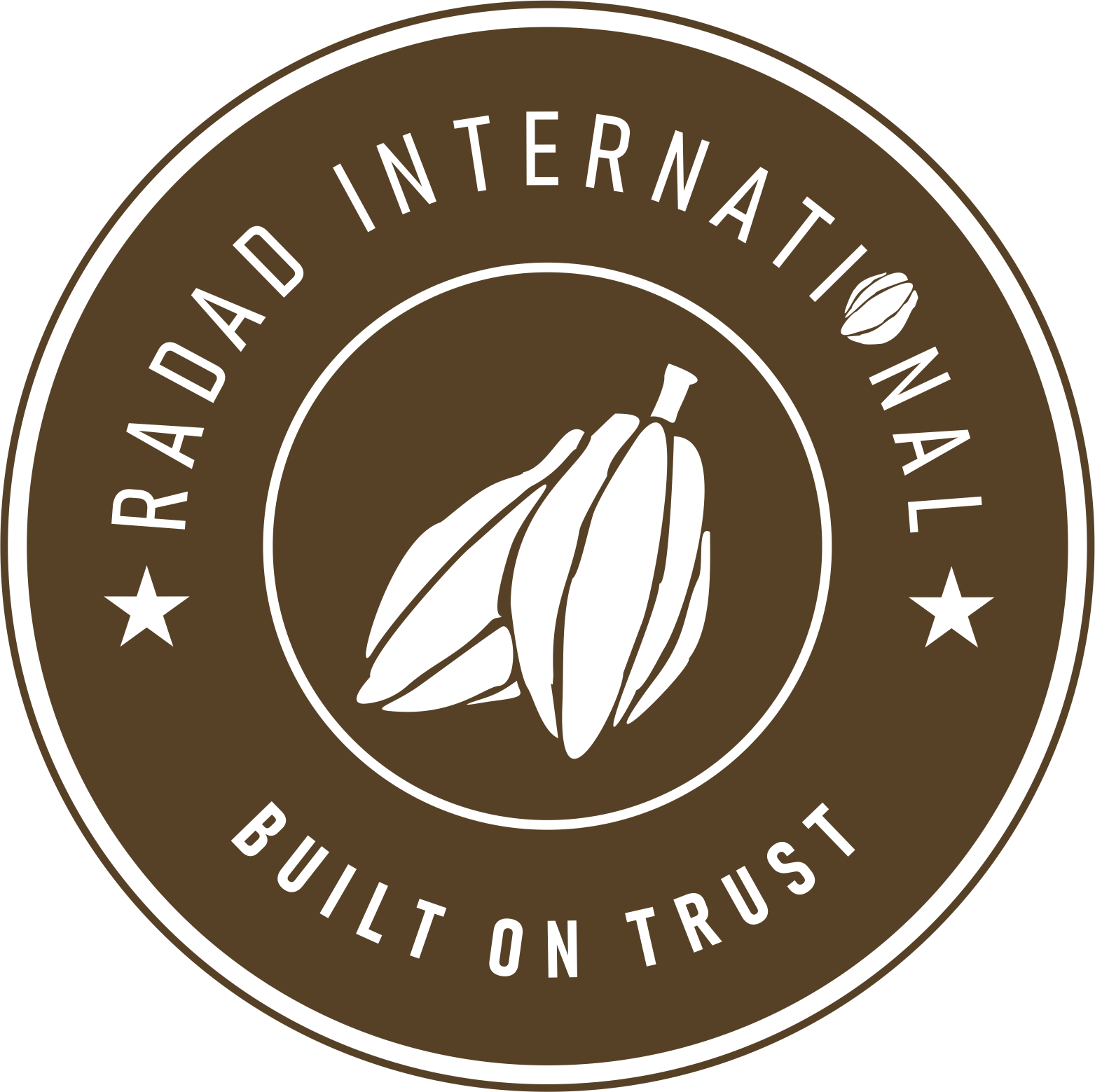When we think of chocolate, most of us picture smooth bars, truffles, or desserts. But before sugar, milk, or flavorings ever enter the picture, there’s one ingredient that forms the very core of it all—cocoa mass.
Also known as cocoa liquor, cocoa mass is made by grinding roasted cocoa nibs (the edible part inside the cocoa bean) into a smooth, rich paste. This paste contains two natural elements of the bean: cocoa solids (responsible for the deep chocolate flavor) and cocoa butter (which gives chocolate its melt-in-your-mouth texture). In other words, cocoa mass is pure chocolate in its rawest form.
Now, when we talk about organic cocoa mass, we’re going a step further. This means the cocoa beans are cultivated without synthetic pesticides, fertilizers, or harmful chemicals. They are typically grown on smaller farms, often in Africa, Latin America, or Asia, where sustainable farming practices and fair trade principles play a big role. The result is a cleaner, more natural ingredient that not only delivers bold, authentic chocolate flavor but also supports healthier soils, ecosystems, and farming communities.
For chocolatiers, bakers, and even cosmetic producers, choosing organic cocoa mass isn’t just about taste—it’s about quality, transparency, and ethics. Whether you’re crafting luxury dark chocolates, premium pastries, or artisanal products, organic cocoa mass provides the rich foundation that makes all the difference.
How Cocoa Mass Is Made?
To appreciate the value of organic cocoa mass, it helps to understand how it’s made. The journey from a raw cocoa bean to a smooth, chocolate-rich paste is both an art and a science. Here’s how it happens:
- Harvesting the Cocoa Pods
Cocoa begins its life inside colorful pods that grow on the cacao tree (Theobroma cacao). Once ripe, these pods are cut open to reveal cocoa beans surrounded by a sweet, white pulp. For organic cocoa, farms avoid harmful chemicals and use natural methods to protect the trees and maintain soil health.
- Fermentation
The beans and pulp are left to ferment for several days under banana leaves or in wooden boxes. This step is crucial—it develops the complex chocolate flavors we love. Without proper fermentation, cocoa mass would taste flat and bitter.
- Drying
After fermentation, beans are spread out under the sun to dry. Sun-drying helps lock in flavor naturally while reducing moisture, making the beans stable for transport. Organic farms usually stick to traditional sun-drying, which is slower but more natural than mechanical drying.
- Roasting
Once dried, beans are roasted to intensify flavor and aroma. Different roasting times and temperatures produce different flavor profiles. For example, beans from Ghana (a major producer of cocoa mass Africa is known for) are often roasted to highlight their deep, earthy, and slightly nutty notes.
- Cracking & Winnowing
The roasted beans are cracked open, and their outer shells are removed. What remains are cocoa nibs—the pure heart of the cocoa bean.
- Grinding into Cocoa Mass (Cocoa Liquor)
The nibs are finely ground, releasing their natural cocoa butter and forming a thick, smooth paste known as cocoa mass or cocoa liquor. At this stage, no sugar, milk, or additives have been introduced. It’s pure, natural chocolate in its most essential form.
- Optional Refining & Conching
Depending on how smooth and premium the end product needs to be, the cocoa mass may go through conching (extended mixing and grinding at controlled temperatures). This improves texture and mellows acidity, making it perfect for cocoa mass for chocolates.
How Cocoa Mass Is Used (In Chocolate & Beyond)
Cocoa mass is often described as the backbone of chocolate-making—but its versatility goes far beyond that. Because it contains both cocoa solids (for flavor) and cocoa butter (for texture), it serves as a foundation for multiple industries.
- Chocolate Manufacturing
- Dark Chocolate – Pure cocoa mass is blended with sugar (and sometimes extra cocoa butter) to create rich, intense dark chocolate. The higher the cocoa mass percentage, the more bitter and deep the flavor.
- Milk Chocolate – Here, cocoa mass is combined with milk powder, sugar, and additional cocoa butter to produce a creamier, sweeter profile.
- White Chocolate – While white chocolate doesn’t contain cocoa mass (only cocoa butter), the quality of the butter—pressed from cocoa mass—directly influences the taste.
- Specialty Chocolates – Artisanal chocolatiers often source premium cocoa mass to achieve unique flavor profiles, using single-origin varieties such as cocoa mass Ghana or other regions in Africa.
- Baking & Confectionery
Professional bakers buy cocoa mass to make:
- Rich brownies, cakes, and pastries with an intense chocolate kick.
- Fillings, ganaches, and truffles where a pure, robust cocoa base is needed. Unlike cocoa powder, cocoa mass also provides fat (from cocoa butter), which contributes to smoothness and richness in desserts.
- Cosmetics & Wellness Products
Because cocoa mass is rich in cocoa butter, it’s often used (directly or as a raw material) in:
- Lip balms
- Skin butters
- Natural soaps and lotions
Its moisturizing and antioxidant properties make it highly valued beyond the kitchen.
Cocoa Mass vs Cocoa Powder: What’s the Difference?
Although they both come from the same cocoa bean, cocoa mass (cocoa liquor) and cocoa powder serve very different purposes.
| Feature | Cocoa Mass (Cocoa Liquor) | Cocoa Powder |
| Definition | Ground paste made from roasted cocoa nibs | Powder left after pressing cocoa butter out of cocoa mass |
| Composition | Contains both cocoa solids + cocoa butter | Mostly cocoa solids, little to no cocoa butter |
| Texture | Thick, paste-like when warm; solid block when cooled | Dry, fine powder |
| Flavor Profile | Rich, intense, and creamy (because of cocoa butter) | Strong chocolate flavor but less creamy (leaner) |
| Uses | Essential base for chocolate making, truffles, ganache, couverture, premium chocolate bars | Baking (cakes, cookies, brownies), hot chocolate, desserts |
| Fat Content | Higher fat content (natural cocoa butter) | Low fat (defatted product) |
| Packaging Options | Often sold in bulk blocks (e.g., 25kg cocoa mass, 5kg cocoa mass) | Usually sold in smaller bags or tins |
| Best For | Chocolatiers, manufacturers, premium chocolate production | Bakers, beverage makers, and dessert chefs |
Why Choose Organic Cocoa Mass?
When it comes to chocolate-making and confectionery, the quality of your cocoa mass directly determines the taste, aroma, and overall experience of the final product. This is where organic cocoa mass truly shines.
1. Pure & Chemical-Free
Organic cocoa mass is produced from cocoa beans grown without pesticides, herbicides, or synthetic fertilizers. That means what you get is as natural as it comes – just cocoa beans, roasted and ground into pure chocolate liquor.
2. Better Flavor Profile
Many chocolatiers agree that organic beans deliver a deeper, cleaner chocolate flavor. Without chemicals interfering, the natural richness and unique terroir of cocoa (especially from regions like Ghana and wider Africa) come through beautifully in the final chocolate.
3. Health Benefits
Organic cocoa mass retains all the goodness of pure cocoa beans – rich in antioxidants, flavonoids, magnesium, and iron. For consumers who are health-conscious, chocolates made with organic cocoa liquor are more appealing because they contain fewer harmful residues.
4. Ethical & Sustainable Choice
Organic cocoa farming often goes hand-in-hand with fair trade practices and sustainability. Buyers looking for premium cocoa mass are not only getting top-quality raw material but also supporting farming communities in Africa, especially cocoa mass from Ghana – one of the world’s leading producers.
5. Consumer Demand is Rising
Globally, there’s a growing demand for organic and clean-label chocolates. Using organic cocoa mass sets your products apart and positions your brand as one that values quality, health, and sustainability.
In short, choosing organic cocoa mass isn’t just about better chocolate – it’s about better business, better health, and better ethics.
How Cocoa Mass is Used in Chocolate Manufacturing
Cocoa mass, or cocoa liquor, is the foundation of every chocolate bar you’ve ever enjoyed. Whether it’s a silky milk chocolate or an intense dark chocolate, the journey starts with cocoa mass. Let’s walk through how it’s used in chocolate production.
1. Bean to Mass
- Cocoa beans are cleaned, roasted, and cracked to release the inner nibs.
- The nibs are ground into a thick, paste-like liquid – this is cocoa mass.
- At this stage, it already contains cocoa solids (flavor) and cocoa butter (texture).
2. Refining & Conching
- Raw cocoa mass is often rough and grainy.
- Through refining and conching (a process of grinding and heating), the mass becomes smooth, while flavors are enhanced and unwanted bitterness is reduced.
- This is where the quality of the mass makes a huge difference – premium cocoa mass ensures a cleaner, more balanced chocolate flavor.
3. Blending with Other Ingredients
Depending on the type of chocolate, cocoa mass is combined with different ingredients:
- Dark Chocolate → Cocoa mass + sugar + sometimes extra cocoa butter.
- Milk Chocolate → Cocoa mass + sugar + milk powder + cocoa butter.
- White Chocolate → Does not contain cocoa mass (only cocoa butter).
The ratio of cocoa mass in the recipe determines how rich, bitter, or smooth the final chocolate will taste. For example, a 70% dark chocolate bar usually means 70% cocoa mass and 30% sugar/other ingredients.
4. Tempering & Molding
- Once blended, the mixture is tempered (carefully heated and cooled) to stabilize the cocoa butter crystals.
- Finally, the chocolate is molded into bars, chips, or other shapes.
PS: Cocoa mass is the backbone of chocolate manufacturing. Its quality influences everything – from the snap of a chocolate bar to the depth of flavor in every bite.
Buying Cocoa Mass: A Practical Guide for Chocolatiers and Buyers
Sourcing high-quality cocoa mass is a critical step for anyone in the chocolate industry. Whether you’re producing artisanal chocolates or large-scale confections, understanding what to look for can save time, money, and ensure a superior final product.
1. Determine the Right Form and Quantity
- Small-scale production: Blocks of 5kg cocoa mass are perfect for artisanal chocolatiers and small bakeries.
- Bulk production: Factories or large-scale operations often buy 25kg cocoa mass or larger bulk cocoa liquor shipments to maintain consistency.
- Knowing your production needs ensures you don’t overstock or compromise quality by using older mass.
2. Check the Origin and Quality
- Cocoa mass flavor and aroma vary depending on the region.
- Cocoa mass Ghana or cocoa mass from Africa is highly valued for its rich, balanced flavor profile.
- Look for suppliers who can provide information about bean origin, processing methods, and certifications, especially if you prefer organic cocoa mass.
3. Consider Storage and Handling
- Cocoa mass should be stored in a cool, dry place, away from strong odors, moisture, and sunlight.
- Proper handling maintains flavor, texture, and shelf life.
4. Reliable Suppliers Matter
- Working with trusted suppliers helps ensure consistency in quality, ethical sourcing, and timely delivery.
- Many chocolatiers source cocoa mass from established suppliers who provide bulk cocoa mass, cocoa mass for chocolates, and traceable origin information.
- For example, companies like Radad International supply cocoa mass from Africa in various formats, making it easier for buyers in regions like the UAE and beyond to access quality ingredients.
5. Tips for Smart Buying
- Request sample blocks to test flavor before committing to large orders.
- Confirm packaging and shipment conditions to avoid exposure to heat or moisture.
- Compare multiple suppliers to ensure you’re getting the best combination of quality, traceability, and price.
FAQs
What Is Cocoa Mass?
Cocoa mass, sometimes called cocoa liquor, is a key component in chocolate production. It’s made by grinding roasted cocoa nibs—the centre of the cocoa bean—into a smooth, thick paste.
This paste contains:
- Cocoa solids – which give chocolate its signature bold flavour.
- Cocoa butter – the natural fat that contributes to creaminess and texture.
In short, cocoa mass is unadulterated chocolate in its purest, most natural form. And when it’s made from organically grown beans, you get organic cocoa mass—free from pesticides, synthetic fertilisers, or GMOs.
How Is Cocoa Mass Used in Chocolate Manufacturing?
Cocoa mass is the starting point for nearly all types of chocolate. The process looks like this:
- Roasting & Cracking – Cocoa beans are roasted, cracked, and winnowed to get cocoa nibs.
- Grinding – Nibs are ground into cocoa liquor (cocoa mass).
- Conching – The mass is further refined, improving smoothness and flavour.
- Blending – Depending on the recipe, sugar, milk powder, and sometimes extra cocoa butter are added.
- Dark chocolate = cocoa mass + sugar (+ optional butter).
- Milk chocolate = cocoa mass + sugar + milk + butter.
- Tempering & Moulding – The mixture is tempered to stabilize crystals, then shaped into bars or pralines.
Without cocoa mass, chocolate as we know it simply wouldn’t exist. Its quality dictates both the intensity of flavour and the texture of the final product.
That’s why premium cocoa mass from the right suppliers makes all the difference for chocolatiers.
What’s the Difference Between Cocoa Mass and Cocoa Powder?
It’s easy to confuse these two, but here’s the breakdown:
- Cocoa mass (cocoa liquor): Made by grinding whole cocoa nibs. Contains both cocoa butter and solids. Used as the base for chocolate.
- Cocoa powder: Created when cocoa mass is pressed to remove most of the butter. What’s left is ground into powder. Great for baking or making hot cocoa.
The key difference is fat content. Cocoa mass has butter + solids, giving it richness. Cocoa powder is low-fat, lighter, and drier.
So if you want to make cocoa mass for chocolates, stick to the whole mass—not the powder.
Does Cocoa Mass Have Caffeine?
Yes, cocoa mass does contain caffeine—it naturally comes from the cocoa bean. However, the amount is much lower than what you’d find in coffee or strong tea.
If you’re sensitive to caffeine, keep in mind that dark chocolate (with more cocoa mass) will usually contain more caffeine than milk chocolate.
Is Cocoa Mass Gluten Free?
Absolutely. Pure cocoa mass is naturally gluten-free since it’s made entirely from cocoa beans.
The only risk comes from cross-contamination. If cocoa mass is processed in a facility that handles wheat, traces of gluten may be present. For those with celiac disease or gluten sensitivity, it’s always best to check labels or choose products specifically certified gluten-free.
What Is Cocoa Mass Made Of?
Cocoa mass is 100% derived from cocoa beans. It’s essentially:
- Non-fat cocoa solids (flavour and antioxidants)
- Cocoa butter (the natural fat of the bean)
That’s it. No additives, no sugar, no milk—just pure, authentic chocolate.
Is Cocoa Mass Vegan and Dairy Free?
Yes! Cocoa mass is naturally vegan and dairy-free. Since it’s made only from cocoa beans, there are no animal-derived ingredients.
However, when cocoa mass is used to make chocolate, milk or other dairy products may be added—so check the labels if you’re looking for vegan-certified chocolate.
How is Cocoa Mass Packaged for Exports?
When you’re looking to buy cocoa mass, you’ll find it available in different forms and sizes:
| Packaging | Best Use Case | Notes |
| 5kg cocoa mass | Small chocolatiers, artisan bakers | Easy to handle, ideal for small-scale recipes. |
| 25kg cocoa mass | Bakeries, cafés, mid-sized chocolate makers | Cost-effective and manageable. |
| Bulk cocoa mass (100kg+) | Large factories, industrial buyers | Usually ordered via cocoa mass suppliers or manufacturers. |
What is The Difference Between COrganic Cocoa Mass | Radad Internatocoa Mass Suppliers, Sellers & Manufacturers
If you’re sourcing cocoa mass, here’s what to look for:
- Cocoa mass suppliers – Middlemen who can provide a range of packaging options (5kg, 10 kg, 25kg, 1000kg to bulk).
- Cocoa mass sellers – Often retailers or wholesalers with stock available to buy directly.
- Cocoa mass manufacturers – Those who process cocoa beans into mass. Buying from them usually means fresher stock and better pricing at scale.
When quality matters, go for suppliers who specialise in organic cocoa mass and premium cocoa mass.

